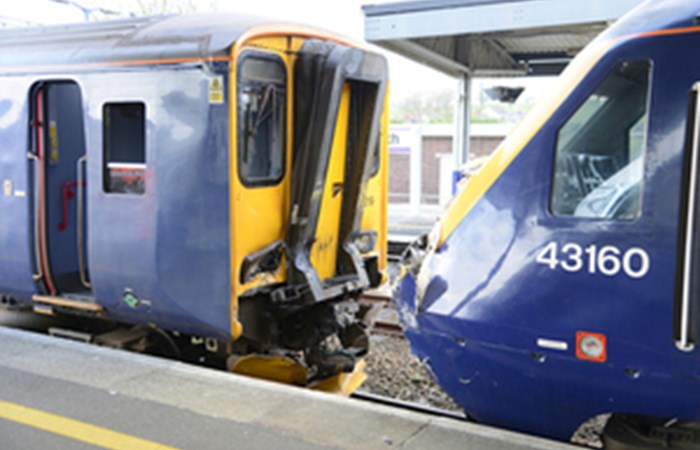Rail Accident Investigation Branch

At 15:34 hrs on Sunday 3 April 2016, a train entering platform 6 at Plymouth station, collided with a stationary train. Around 35 people, including the driver of one of the trains were injured, some seriously.
The stationary train, 1A91, had arrived in platform 6 around 34 minutes before the collision. This train would normally have used platform 7. On this occasion it could not, because the platform lifts were closed for planned maintenance and the train required its catering supplies to be restocked before its onward journey to London Paddington at 15:41 hrs. At the time of the collision, train 1A91 had one member of staff on board.
Train 2E68 was the 13:39 hrs service from Penzance to Exeter. It was formed of two class 150 diesel multiple units coupled together; a total of four vehicles. There were approximately 60 passengers on the train as it approached Plymouth. This train was booked into platform 8 at Plymouth but the signaller decided to signal the train into platform 6 behind train 1A91 so that passengers intending to catch train 1A91 could do so easily as the lifts were not working on both platforms 7 and 8. Allowing trains to share a platform is known as permissive working, and is allowed for passenger trains using platform 6. The signaller could see the rear of train 1A91 from the signal box window and estimated that there was enough room for train 2E68 to fit on the platform behind train 1A91, however, there was insufficient room.
Approaching Plymouth station from the west, the data recorder fitted to train 2E68 showed the train slowed to about 14 mph (22 km/h) approaching signal P15 on the approach to Plymouth station. This signal cleared from red (meaning stop) to an indication meaning that the train may proceed into platform 6, but that the driver must be prepared to stop short of any train, vehicle or obstruction. Signal P15 is located around 333 metres from where the rear of train 1A91 stood.
The train then accelerated to a speed of around 21 mph (34 km/h) and as train 2E68 approached Plymouth station through a relatively tight, left-hand curve, the driver saw train 1A91 in platform 6 ahead. The driver was surprised to see the rear of train 1A91 so close to the west end of the platform. He looked at the tracks to confirm which route the train was taking and, realising a collision was imminent, applied the emergency brake. This was around three seconds before the collision, which occurred at about 15 mph (24 km/h). Many passengers were standing in preparation to leave the train and were thrown into the trains fixtures and onto the floor.
Our investigation will include examination of:
- the actions of staff involved
- the signalling and platform working arrangements at Plymouth station
- the performance of the train during the collision
- any underlying management factors.
Our investigation is independent of any investigation by the railway industry, the British Transport Police or by the industrys regulator, the Office of Rail and Road.
We will publish our findings, including any safety recommendations at the conclusion of our investigation; these will be available on our website.
You can subscribe to automated emails notifying you when we publish our reports.
